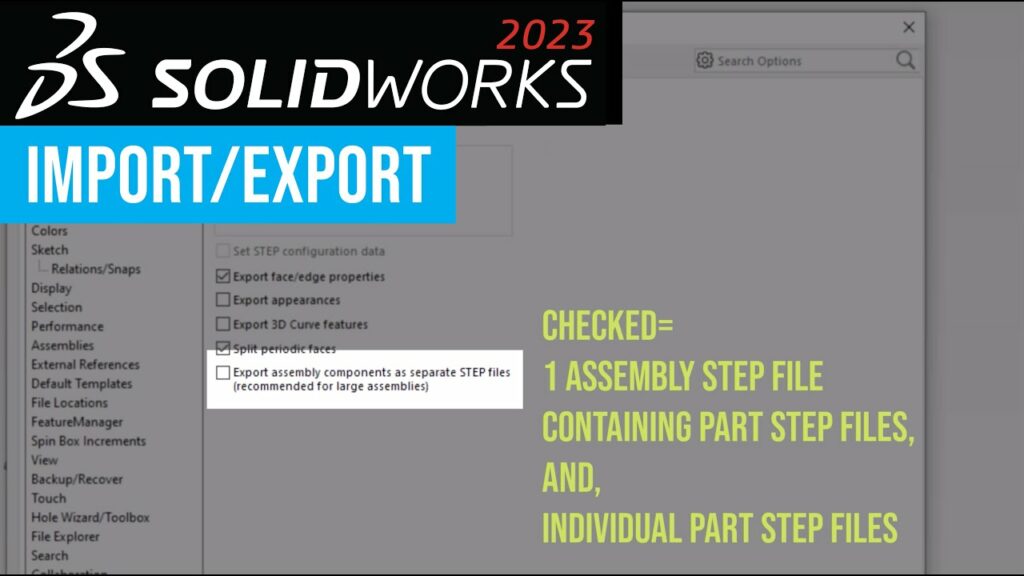Navigating Seamless Data Exchange: A Comprehensive Guide to Importing and Exporting Files in SolidWorks

SolidWorks, a leading CAD (Computer-Aided Design) software, empowers designers and engineers to create intricate 3D models and assemblies with precision and efficiency. However, collaboration and interoperability often require the exchange of data between SolidWorks and other software applications or file formats. Understanding how to import and export files in SolidWorks is essential for seamless data exchange, efficient collaboration, and workflow optimization. In this exhaustive guide, we will delve into the intricacies of importing and exporting files in SolidWorks, from navigating different file formats to implementing best practices for preserving design integrity and compatibility across platforms.
Understanding Import and Export Options in SolidWorks:
- SolidWorks offers a variety of import and export options to facilitate data exchange with other CAD software, file formats, and design platforms.
- Import options allow users to bring external data, such as 3D models, assemblies, or drawings, into SolidWorks for editing, referencing, or integration into existing designs.
- Export options enable users to save SolidWorks files in different formats, making them accessible to users of other software applications or platforms.
Importing Files into SolidWorks:
- To import files into SolidWorks, navigate to the File menu and select the Import option. Choose the desired file format from the list of supported formats, such as STEP, IGES, Parasolid, or STL.
- Follow the prompts to locate and select the file you wish to import, and adjust import settings as needed, such as units, orientation, or geometry conversion options.
- After importing the file, review and verify the imported geometry, making any necessary adjustments or modifications to ensure compatibility and accuracy within the SolidWorks environment.
Exporting Files from SolidWorks:
- To export files from SolidWorks, open the desired part, assembly, or drawing file, and navigate to the File menu. Select the Save As or Export option, depending on the desired file format and export destination.
- Choose the appropriate file format from the list of supported formats, such as STEP, IGES, DWG, DXF, or STL, and specify the file name, location, and export settings.
- Adjust export settings as needed, such as units, scale, or resolution, to ensure compatibility and accuracy when transferring the file to other software applications or platforms.
Best Practices for Importing and Exporting Files in SolidWorks:
- Verify Compatibility: Before importing or exporting files, verify compatibility between SolidWorks and the target software or platform to ensure seamless data exchange.
- Standardize File Formats: Standardize file formats and naming conventions within your organization to streamline data exchange and collaboration across teams and projects.
- Maintain Design Integrity: When exporting files from SolidWorks, preserve design integrity by maintaining accurate dimensions, tolerances, and annotations, and minimizing data loss or distortion.
- Check for Errors: After importing files into SolidWorks, check for any errors, inconsistencies, or missing features that may require correction or adjustment to ensure the imported geometry meets design requirements.
- Collaborate Effectively: Foster effective collaboration by communicating with stakeholders and partners throughout the import and export process, addressing any concerns or requirements proactively to facilitate smooth data exchange and workflow integration.
Conclusion:
- Importing and exporting files in SolidWorks is essential for seamless data exchange, efficient collaboration, and workflow optimization.
- By understanding the import and export options available in SolidWorks, implementing best practices for preserving design integrity and compatibility, and fostering effective collaboration across teams and projects, users can maximize the benefits of data exchange and enhance productivity in their design workflows.
- Embrace these strategies and techniques to navigate seamless data exchange in SolidWorks and unlock the full potential of your design capabilities for innovation and success.




